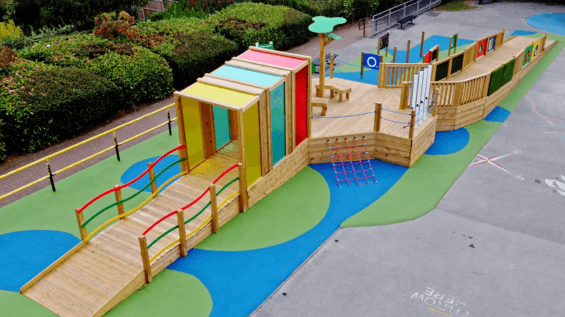
May

Why Sensory Play is Crucial for Child Development
Children thrive when they play. But not all play is created equal. Sensory play—which engages children through touch, sound, sight, smell, balance, and movement—is one of the most powerful forms of learning and development available. At Caloo, we understand the immense impact sensory play can have on children of all ages and abilities, which is why we champion inclusive, sensory-rich outdoor spaces across the UK.
In this blog, we explore why sensory play matters, how it supports child development, and how Caloo’s expertly designed playground equipment can help schools, councils, and community groups provide better play experiences for every child.
What is Sensory Play?
Sensory play encompasses activities designed to stimulate a child’s senses, including touch, sight, sound, smell, taste, balance (vestibular), and spatial awareness (proprioception). It includes simple interactions like squishing mud between fingers or listening to the sound of wind chimes, as well as more structured activities like climbing textured trails or engaging with musical play panels.
Examples of sensory play in outdoor settings include:
• Water and sand play areas
• Musical instruments like drums and chimes
• Texture-rich climbing walls or trails
• Tactile panels featuring different materials
• Movement-based equipment such as swings or roundabouts
Sensory play is particularly effective when outdoors, where natural elements like sunlight, breeze, and birdsong complement the equipment and enhance the experience.
How Sensory Play Aids Child Development
Cognitive Development
Sensory activities support early brain development by strengthening neural pathways associated with memory, language, problem-solving, and concentration. Through repeated, hands-on experiences, children begin to understand how the world works. For example, pouring water from one container to another introduces concepts like volume, cause and effect, and physics.
Physical Development
Fine motor skills (such as grasping, pinching, and writing) are developed through tactile activities like digging in sand or turning knobs on play panels. Gross motor skills (like running, balancing, or climbing) are refined through movement-based sensory experiences. Outdoor play zones designed by Caloo often incorporate varied surfacing and climbing structures to support whole-body coordination.
Social and Emotional Development
Group sensory play fosters collaboration, turn-taking, and conflict resolution. Children learn to communicate their ideas, share resources, and develop empathy. It also provides emotional regulation benefits—soothing sensory inputs like gentle textures or calming sounds can reduce anxiety and improve mood.
Sensory Integration
Children learn how to process, prioritise, and respond to sensory input. For children with sensory processing differences, this integration is key to functioning successfully in everyday environments. Structured outdoor sensory play helps these children develop tolerance, confidence, and enjoyment.
Why Outdoor Sensory Play is Especially Powerful
Outdoor environments naturally stimulate multiple senses. Compared to indoor settings, outdoor sensory play:
• Encourages larger movements and active play
• Exposes children to a wider range of sensory stimuli (e.g. weather, textures, smells)
• Reduces overstimulation from artificial lights and sounds
• Supports better sleep, mood, and physical health
Outdoor sensory zones can be a game-changer for children with conditions such as ADHD, autism, or anxiety. Natural elements combined with sensory-focused equipment create calm, predictable environments where children can thrive.
The Role of Sensory Play in Inclusive Environments
Inclusion means creating spaces where every child—regardless of ability—can engage, participate, and flourish. Sensory play is an essential part of this mission.
Children with autism spectrum conditions, visual or auditory impairments, or physical disabilities often rely more heavily on certain senses. Offering varied sensory input ensures no child is left out. For example:
• Musical panels provide auditory feedback for children with visual impairments
• Textured paths and handrails assist those with mobility challenges
• Calming zones with gentle sounds or quiet seating areas benefit children with sensory sensitivities
At Caloo, we design inclusive play areas that promote engagement and empathy. Our inclusive playground equipment includes tactile walls, accessible activity panels, wheelchair-friendly paths, and more—ensuring sensory play is available to all.
How Caloo Designs Sensory Play Spaces That Support Development
Caloo provides a complete service from consultation and design to installation and aftercare. We create bespoke outdoor play areas that meet specific user needs, school curriculums, and community goals.
We use timber and steel playground equipment, alongside a wide range of surfacing options, to craft safe and stimulating sensory environments. Our sensory play products are designed to:
• Encourage active exploration
• Promote inclusive learning
• Inspire creativity
Whether it’s a clamber stack in a school playground or a musical trail in a public park, our installations are built to last and tailored to support developmental outcomes.
Example: Inclusive Primary School Sensory Trail
In a recent project with a UK primary school, Caloo installed a sensory trail featuring textured stepping stones, balance beams, musical posts, and quiet seating zones. Teachers reported improvements in focus, social interactions, and outdoor learning outcomes.
Supporting Councils and Schools: Getting Started with Sensory Play
We know that investing in outdoor play can feel daunting. Caloo makes it simple for schools, councils, and community groups by offering:
• Expert consultation and site assessments
• Designs aligned with Section 106 planning requirements (LAPs, LEAPs, NEAPs)
• Durable, low-maintenance products
• Safety surfacing installation (Wetpour, artificial grass, rubber mulch, SUDs Bond, and more)
• Ongoing maintenance and inspection packages
Our team helps identify the right mix of sensory, inclusive, and active play equipment for your needs. From planning and funding advice to full project delivery, we’re here to help every step of the way.
Final Thoughts: A Lasting Investment in Childhood
Sensory play isn’t just an educational trend—it’s a fundamental aspect of child development. When thoughtfully incorporated into outdoor spaces, sensory play creates inclusive, engaging, and joyful environments where children can grow physically, emotionally, and socially.
At Caloo, we believe that every child deserves the chance to explore, discover, and connect through play. Whether you’re designing a new community park, upgrading a school playground, or planning a housing development play area, our team is ready to help you build something special.
Ready to add sensory value to your outdoor space? Contact Caloo today and let’s create a play environment where every child can thrive.

















